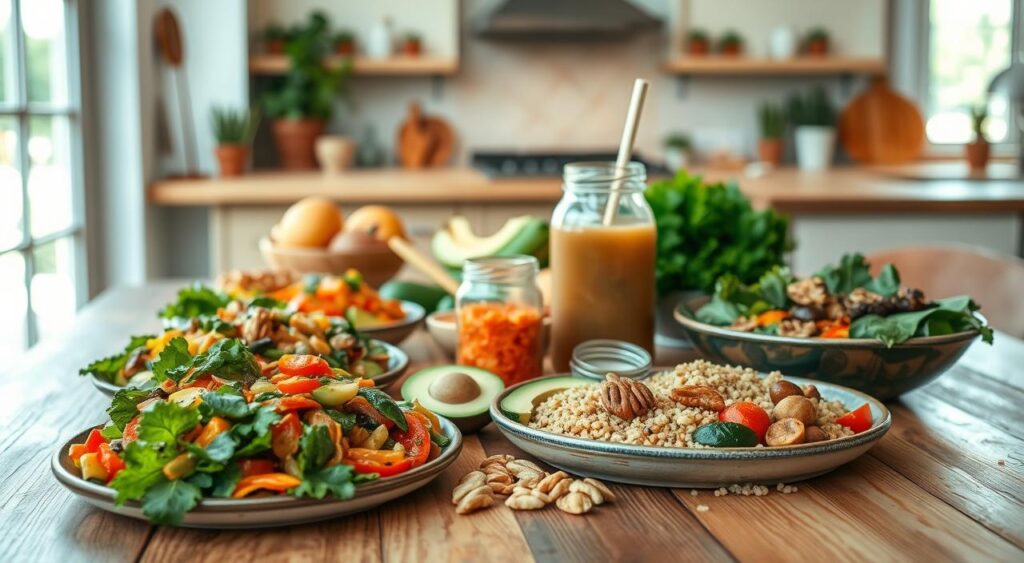Maintaining a healthy gut is crucial for overall wellbeing, influencing everything from immune function and mental health to energy levels. The food you eat plays a significant role in either supporting or hindering gut health. While some foods can naturally enhance your gut health, others can be detrimental. In today’s fast-paced world, finding time to prepare nutritious dinners can be challenging, but it’s essential for sustaining healthy eating habits.
Fortunately, healthy dinners don’t have to be complicated or time-consuming. You can prepare delicious, gut-friendly meals in 30 minutes or less. This article will introduce you to 9 powerful dinner recipes that not only support digestive health but are also family-friendly and easy to make.
Key Takeaways
- Discover 9 easy-to-make dinner recipes that boost gut health.
- Learn how to prepare nutritious meals in 30 minutes or less.
- Understand the importance of gut health for overall wellbeing.
- Explore ingredients that naturally support digestive health.
- Find healthy dinner ideas that are family-friendly.
Understanding the Gut-Diet Connection
The foods you eat play a significant role in shaping the health of your digestive system. Your gut is home to trillions of bacteria, known as the gut microbiome, which affects everything from your immunity to your mood.
To understand how food impacts your gut, let’s first explore how it affects your digestive system. The gut microbiome is directly influenced by the foods you consume, with certain ingredients supporting beneficial bacteria and others harming them.
How Food Affects Your Digestive System
The digestion process involves breaking down food into nutrients that your body can absorb. Different foods are processed differently, with some providing essential fiber and probiotics that support gut health. For instance, a healthy meal rich in fiber can help regulate bowel movements and support the growth of beneficial bacteria.
| Food Component | Benefit to Gut Health |
|---|---|
| Fiber | Regulates bowel movements and supports beneficial bacteria |
| Probiotics | Introduces beneficial bacteria into the gut |
| Antioxidants | Reduces inflammation and oxidative stress |
Signs of an Unhealthy Gut
An unhealthy gut can manifest in various ways, including bloating, irregular bowel movements, fatigue, skin issues, and food intolerances. Making healthier dinner choices can help restore gut balance and improve digestive symptoms. Incorporating gut-friendly dinner recipes rich in fiber, probiotics, and antioxidants can be a step towards better gut health.
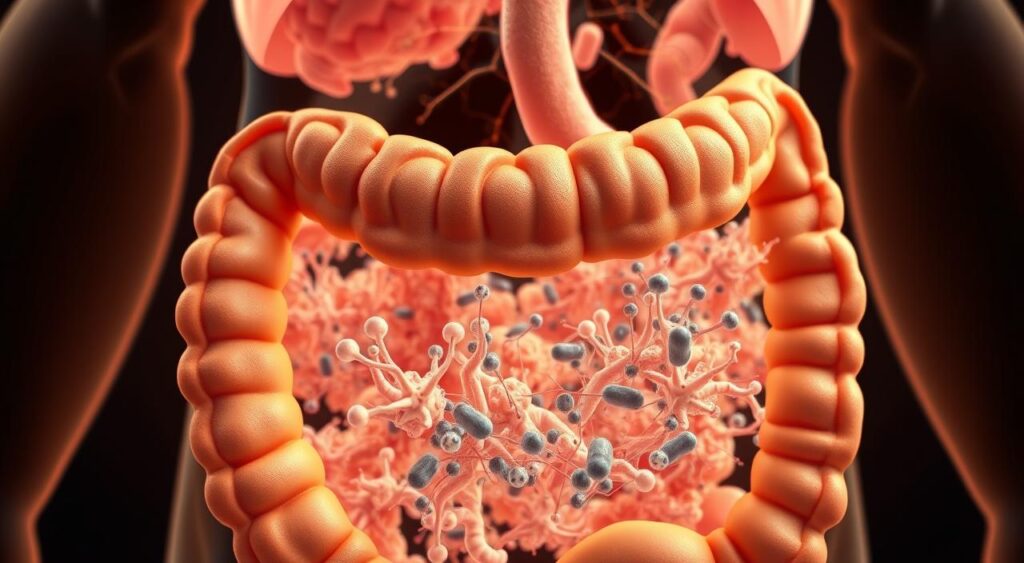
Gut-Friendly Ingredients to Keep in Your Kitchen
To support your gut health journey, it’s essential to have a well-stocked kitchen with gut-friendly ingredients. By incorporating the right foods into your diet, you can promote a balanced gut microbiome and overall well-being.
Fiber-Rich Foods for Digestive Health
Dietary fiber plays a crucial role in maintaining a healthy gut. It acts as a prebiotic, feeding beneficial bacteria and promoting regular bowel movements. Include a variety of fiber-rich foods in your diet, such as whole grains (oats, quinoa, brown rice), legumes (lentils, chickpeas, black beans), vegetables (broccoli, carrots, leafy greens), and fruits (apples, berries, bananas).
| Food Category | Examples |
|---|---|
| Whole Grains | Oats, Quinoa, Brown Rice |
| Legumes | Lentils, Chickpeas, Black Beans |
| Vegetables | Broccoli, Carrots, Leafy Greens |
| Fruits | Apples, Berries, Bananas |
Fermented Foods and Probiotics
Fermented foods like yogurt, kefir, sauerkraut, kimchi, and kombucha introduce beneficial bacteria to the gut, supporting a balanced microbiome. These foods contain probiotics, which work in tandem with prebiotics to promote gut health. Including a variety of fermented foods in your diet can help maintain a healthy gut.
“The gut is the gateway to our overall health, and fermented foods are a key part of maintaining a balanced gut microbiome.”
Anti-Inflammatory Ingredients
Chronic inflammation in the gut can lead to digestive disorders. Incorporating anti-inflammatory ingredients like turmeric, ginger, olive oil, fatty fish, and leafy greens can help reduce gut inflammation. These foods promote healing and support overall gut health.
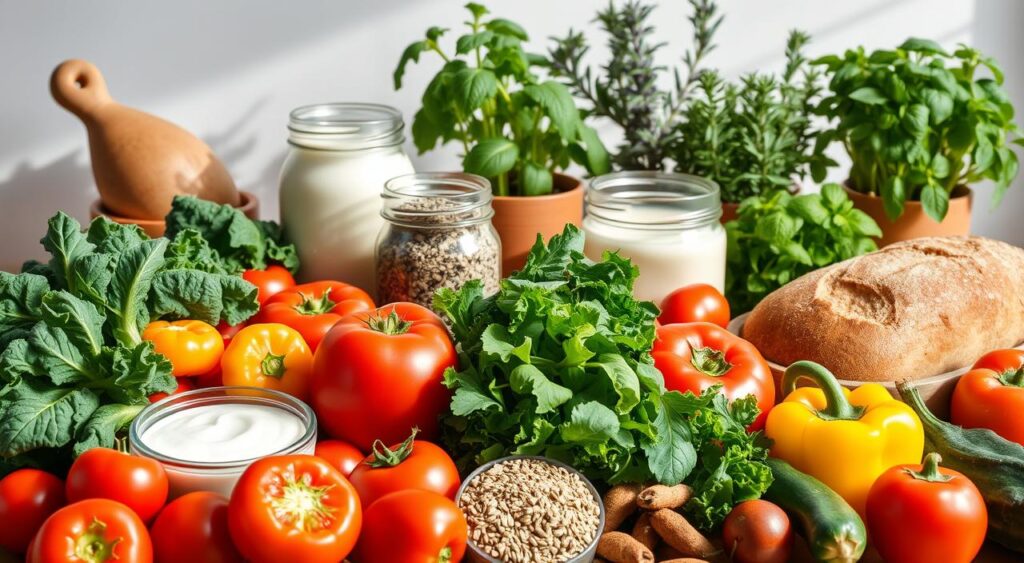
By incorporating these gut-friendly ingredients into your daily meals, you can take a proactive approach to supporting your gut health. Experiment with new recipes and flavors to keep your diet interesting and enjoyable.
Quick Healthy Dinner Recipes for Better Gut Health
Gut health is closely linked to the food we eat, and having a repertoire of quick healthy dinner recipes can make all the difference. Incorporating the right ingredients into your meals can help support a healthy gut microbiome, leading to overall well-being.
Salmon and Asparagus Foil Packs with Garlic Lemon Butter
This recipe is a perfect blend of omega-3 rich salmon and prebiotic fiber-rich asparagus, all wrapped up in a flavorful garlic lemon butter sauce. To make, you’ll need:
- 4 salmon fillets
- 1 pound fresh asparagus
- 2 cloves garlic, minced
- 2 lemons, juiced
- 2 tablespoons unsalted butter
Prep Time: 15 minutes | Cook Time: 12 minutes
Nutritional Benefits: Salmon provides omega-3 fatty acids that reduce gut inflammation, while asparagus offers prebiotic fiber to support beneficial gut bacteria.
Mediterranean Chickpea Salad Bowl
This salad is a powerhouse of fiber, plant protein, and anti-inflammatory compounds. To make, combine:
- 1 can chickpeas, drained and rinsed
- 1 cup cherry tomatoes, halved
- 1/2 cup cucumber, sliced
- 1/4 cup red onion, thinly sliced
- 2 tablespoons olive oil
- 1 tablespoon lemon juice
Prep Time: 10 minutes | Cook Time: 0 minutes
Nutritional Benefits: Chickpeas provide fiber and plant protein, while olive oil offers anti-inflammatory benefits.
Gut-Healing Chicken and Vegetable Soup
This soothing soup combines lean protein with gut-healing bone broth and fiber-rich vegetables. To make, you’ll need:
- 1 pound boneless, skinless chicken breast
- 4 cups chicken bone broth
- 1 large onion, diced
- 2 cloves garlic, minced
- 2 carrots, peeled and sliced
Prep Time: 20 minutes | Cook Time: 25 minutes
Nutritional Benefits: Chicken provides lean protein, while bone broth offers gut-healing properties and vegetables add fiber.
Probiotic-Rich Yogurt Marinated Chicken Skewers
These skewers incorporate beneficial bacteria through the yogurt marinade, making them a great option for gut health. To make, combine:
- 1 cup plain yogurt
- 1 pound boneless, skinless chicken breast, cut into bite-sized pieces
- 1/4 cup lemon juice
- 2 cloves garlic, minced
Prep Time: 15 minutes | Cook Time: 10 minutes
Nutritional Benefits: Yogurt provides probiotics, while chicken offers lean protein.
Anti-Inflammatory Turmeric Cauliflower Rice Bowl
This recipe combines the powerful anti-inflammatory properties of turmeric with low-carb cauliflower rice. To make, you’ll need:
- 1 head cauliflower
- 2 tablespoons coconut oil
- 1 teaspoon turmeric powder
- 1/2 teaspoon salt
Prep Time: 10 minutes | Cook Time: 5 minutes
Nutritional Benefits: Turmeric provides anti-inflammatory compounds, while cauliflower offers a low-carb alternative to traditional rice.
Fiber-Packed Zucchini Noodles with Pesto and Vegetables
This recipe offers a low-carb alternative to traditional pasta while providing plenty of fiber. To make, combine:
- 2 medium zucchinis
- 1/4 cup pesto
- 1 cup cherry tomatoes, halved
- 1/2 cup sliced bell peppers
Prep Time: 15 minutes | Cook Time: 5 minutes
Nutritional Benefits: Zucchini provides fiber, while pesto offers healthy fats.
Prebiotic Garlic Shrimp with Sautéed Greens
This recipe explains how garlic acts as a prebiotic to feed beneficial gut bacteria. To make, you’ll need:
- 1 pound large shrimp, peeled and deveined
- 3 cloves garlic, minced
- 2 cups mixed greens
- 1 tablespoon olive oil
Prep Time: 10 minutes | Cook Time: 4 minutes
Nutritional Benefits: Garlic acts as a prebiotic, while shrimp provides lean protein.
Kimchi Fried Rice with Eggs
This recipe incorporates fermented kimchi for probiotic benefits along with protein-rich eggs. To make, combine:
- 2 cups cooked rice
- 1 cup kimchi, chopped
- 2 eggs, beaten
- 1 tablespoon coconut oil
Prep Time: 15 minutes | Cook Time: 10 minutes
Nutritional Benefits: Kimchi provides probiotics, while eggs offer protein.
Soothing Ginger Sesame Salmon Salad
This salad combines anti-inflammatory ginger with omega-3 rich salmon. To make, you’ll need:
- 4 salmon fillets
- 2 inches ginger, grated
- 2 tablespoons sesame oil
- 4 cups mixed greens
Prep Time: 15 minutes | Cook Time: 0 minutes
Nutritional Benefits: Salmon provides omega-3 fatty acids, while ginger offers anti-inflammatory benefits.
Time-Saving Tips for Gut-Healthy Cooking
Gut-healthy cooking can be quick and easy with the right strategies. By implementing a few simple techniques, you can enjoy healthy dinners without sacrificing too much time.
Meal Prep Strategies for Busy Weeknights
Meal prep is a game-changer for busy weeknights. By preparing gut-healthy ingredients in advance, such as washing and chopping vegetables, pre-cooking grains, and marinating proteins, you can save a significant amount of time during the week. You can also batch cook gut-friendly components that can be mixed and matched to create different meals. Proper storage of prepped ingredients is crucial to maintain their nutritional value and extend their shelf life.
One-Pan and Sheet Pan Cooking Methods
One-pan and sheet pan cooking methods simplify cleanup while delivering nutritious, gut-supporting meals. You can combine proteins, vegetables, and gut-friendly seasonings on a single pan for a quick and easy dinner. For example, a sheet pan dinner with roasted chicken, sweet potatoes, and broccoli is a healthy and satisfying option. Using time-saving kitchen tools like pressure cookers, air fryers, and food processors can also make gut-healthy cooking more efficient.
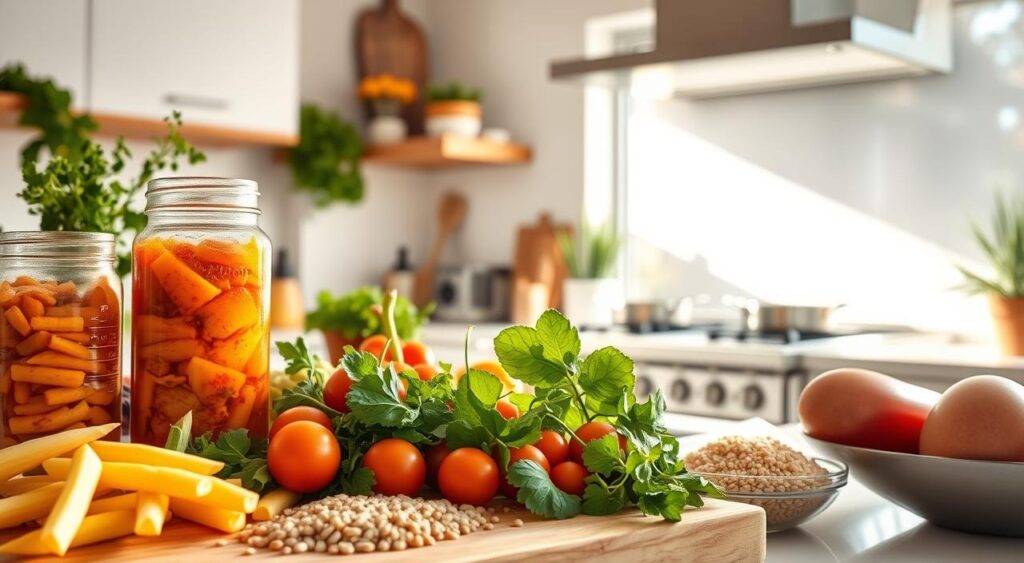
How to Incorporate These Recipes Into Your Weekly Routine
Creating a balanced gut-health meal plan is the first step to incorporating these recipes into your weekly routine. By planning your meals, you can ensure that you’re getting a variety of gut-friendly ingredients while maintaining nutritional diversity.
Creating a Balanced Gut-Health Meal Plan
To create a balanced meal plan, start by selecting a mix of recipes that include different gut-supporting ingredients. For example, you can rotate betweenfermented foodslike kimchi and sauerkraut,fiber-rich vegetablessuch as broccoli and carrots, andprobiotic-rich foodslike yogurt and kefir. This variety will provide a broad spectrum of nutrients and beneficial compounds.
Some tips for creating a balanced meal plan include:
- Plan your meals around seasonal produce to ensure freshness and variety.
- Incorporate a mix of cooking methods, such as grilling, roasting, and sautéing, to keep meals interesting.
- Make sure to include a source of protein, healthy fat, and complex carbohydrates in each meal.
Adapting Recipes to Your Dietary Needs
Adapting these recipes to your dietary needs is crucial for maintaining their gut health benefits. Whether you’regluten-free,dairy-free,vegetarian, orvegan, you can modify the ingredients to suit your requirements. For instance, you can substitute gluten-containing grains with gluten-free alternatives like rice or quinoa.
When adapting recipes, consider the following:
- Replace dairy products with non-dairy alternatives like almond milk or coconut yogurt.
- Use plant-based protein sources like beans, lentils, or tofu for vegetarian and vegan options.
- Be mindful of hidden sources of gluten, dairy, or other allergens in packaged ingredients.
By incorporating these strategies into your meal planning, you can enjoy a diverse and gut-friendly diet that meets your dietary needs.
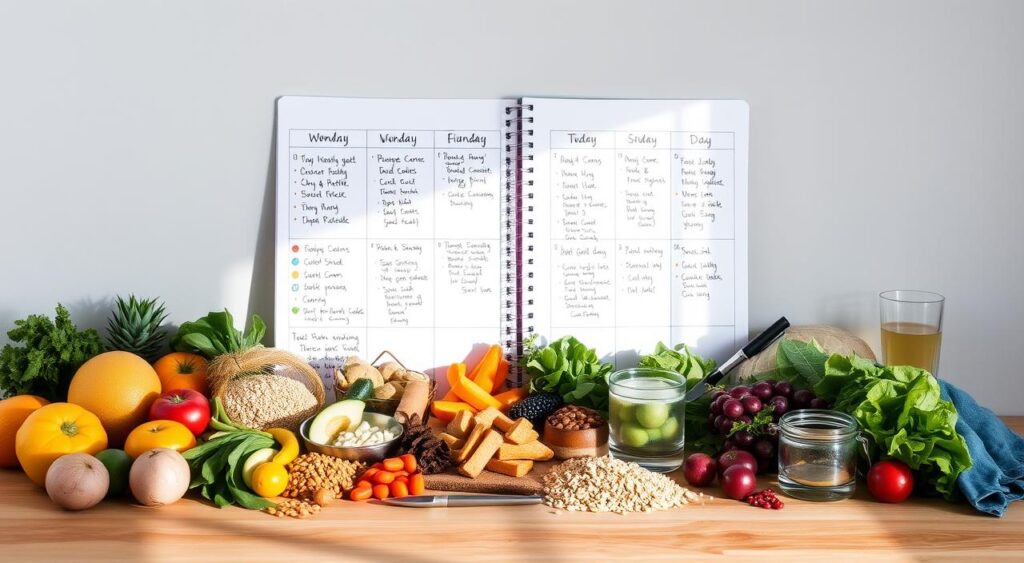
Common Mistakes to Avoid When Cooking for Gut Health
Even with the best recipes, common cooking mistakes can negatively impact gut health. When preparing dinner, it’s crucial to avoid errors that can undermine the benefits of your healthy meal.
Some common mistakes include overcooking vegetables, which can destroy their nutrients, and using excessive heat with healthy oils, making them harmful. Additionally, many condiments and pre-packaged foods contain hidden gut-irritating ingredients.
- Be mindful of food combinations that might cause digestive distress, even if the individual ingredients are gut-friendly.
- Avoid relying too heavily on one type of gut-supporting food, like fermented foods, while neglecting others, such as fiber-rich foods.
- Steer clear of artificial sweeteners and food additives that can disrupt gut bacteria.
- For those with sensitive digestive systems, be cautious with consuming too many raw vegetables.
- Pay attention to proper portion sizes to prevent overloading your digestive system.
- Identify your personal food triggers that might cause gut issues despite being healthy for most people.
By avoiding these common mistakes, you can maximize the gut health benefits of your dinner and support a healthy digestive system.

Conclusion: Nourishing Your Gut with Quick Healthy Dinner Recipes
Nourishing your gut with the right foods is simpler than you think. By incorporating quick healthy dinner recipes into your meal routine, you can significantly improve your gut health. The recipes provided earlier offer a variety of healthy dinner options that are not only delicious but also support digestive wellness. Start with these nine gut-boosting recipes and adapt them to your dietary needs. As you make these changes, you’ll likely notice improvements in digestion, immunity, and mental clarity.
Experiment with these dinner recipes and share your experiences to help others on their gut health journey.
FAQ
What are some easy ways to start incorporating gut-friendly ingredients into my meals?
You can start by adding fiber-rich foods like vegetables, fruits, and whole grains to your diet. You can also try incorporating fermented foods like kimchi or sauerkraut into your meals.
How do I know if I’m experiencing signs of an unhealthy gut?
Common signs of an unhealthy gut include bloating, abdominal pain, and changes in bowel movements. If you’re experiencing these symptoms, it’s a good idea to consult with a healthcare professional.
Can I still enjoy my favorite foods while following a gut-healthy diet?
Yes, you can still enjoy your favorite foods in moderation. The key is to balance them with nutrient-dense, gut-friendly ingredients. You can also try adapting your favorite recipes to make them healthier.
How can I save time while cooking gut-healthy meals?
You can save time by using meal prep strategies, one-pan cooking methods, and keeping a well-stocked kitchen with gut-friendly ingredients. You can also prep ingredients in advance to make cooking easier.
Are there any specific ingredients I should avoid when cooking for gut health?
Yes, it’s a good idea to limit or avoid ingredients that can be inflammatory or hard to digest, such as processed meats, sugary foods, and foods high in saturated fats. Instead, focus on whole, nutrient-dense foods.
Can I customize these recipes to suit my dietary needs and preferences?
Absolutely, you can adapt these recipes to suit your dietary needs by swapping out ingredients or adjusting portion sizes. You can also get creative and add your own favorite ingredients to make the recipes your own.
How can I make sure I’m getting enough protein in my gut-healthy meals?
You can include a variety of protein sources in your meals, such as chicken, fish, beans, lentils, and tofu. You can also try incorporating protein-rich fermented foods like tempeh or seitan.
Are there any gut-friendly ingredients that are also budget-friendly?
Yes, many gut-friendly ingredients are also budget-friendly, such as beans, lentils, and frozen vegetables. You can also buy in bulk and plan your meals around seasonal produce to save money.
